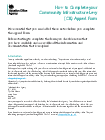Community Infrastructure Levy: how to make an appeal
A developer’s guide to appealing a Community Infrastructure Levy with the Valuation Office Agency.
Applies to England and Wales
Community Infrastructure Levy overview
The Community Infrastructure Levy (CIL) is a planning charge, introduced by the Planning Act 2008 as a tool for local authorities in England and Wales. It is used to provide infrastructure to support the development of their area. A development may be liable for a CIL charge if a local planning authority has chosen to set a charge in its area.
You can find out how CIL operates on the Planning Portal.
Appeals dealt with by the Valuation Office Agency
You can appeal against a CIL charge to the Valuation Office Agency (VOA) if:
- the collecting authority’s calculation of the chargeable amount (a regulation 114 appeal)
- the collecting authority’s apportionment of a CIL charge between different landowners in ‘default’ cases (a regulation 115 appeal)
- the collecting authority’s determination of the value of the interest in land in respect of which charitable relief was claimed (a regulation 116 appeal)
- the collecting authority’s decision not to grant exemption for a residential annex because the annex is not wholly within the curtilage of the main dwelling (a regulation 116A appeal)
- the collecting authority’s calculation of the amount of the exemption for self-build housing (a regulation 116B appeal)
- the collecting authority’s calculation of ‘notional relief’ under Schedule 1, paragraph 7(5) (a Schedule 1, paragraph 9 appeal).
Appeals to the VOA can be made electronically or in hard copy.
You can download the CIL appeal form and either email it to the VOA, together with any attachments, or send a hard copy to the address below.
Further details of the different types of appeal can be found in the VOA’s Community Infrastructure Levy Manual.
You can appeal other levy enforcement actions to the Planning Inspectorate.
Assistance with appealing a CIL decision
Guidance on how to complete the Community Infrastructure Levy appeal form
PDF, 70.2KB, 7 pages
This file may not be suitable for users of assistive technology.
A quick guide to the Community Infrastructure Levy appeal process
PDF, 23.5KB, 3 pages
This file may not be suitable for users of assistive technology.
Frequently Asked Questions and Responses
PDF, 47KB, 3 pages
This file may not be suitable for users of assistive technology.
Where to send a hard copy appeal form
Please send all documents by email if possible. If not this is not possible for every document that you have then please email as many documents as you can and alert us that others have been sent by hard copy. Please be aware that it is taking us longer than usual to respond to customers and there may be a delay in processing your appeal but please be assured that we will get back to you as soon as we can.
If you want to send the completed appeal form and any attachments by hard copy they should be sent to:
Valuation Office Agency
DVS (CIL)
Wycliffe House
Green Lane
Durham
DH1 3UW
Contact
If you have any queries about making an appeal against your CIL charge contact [email protected].
If you have any other queries about the operation of the CIL please refer to the Planning Portal.
Updates to this page
Published 10 November 2014Last updated 10 August 2020 + show all updates
-
Opening paragraph removed to reflect our phone lines re-opening after the coronavirus outbreak.
-
First published.



